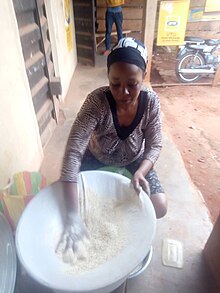Okpa
Appearance


Okpa (pronounced Ọkpa) is a dish prepared by the Igbo people with a type of beans known as bambara nuts.[1] It is common in Enugu state and Niger state and classified as a traditional Nigerian delicacy. Other ethnic groups also eat it (with pap or alone).[2] Other Igbo names for okpa include ịgba and ntucha. In Hausa, it is known as gurjiya or kwaruru.[3]
The main ingredients in okpa are bambara nut flour, pepper, palm oil and seasoning.It is prepared with pumpkin leaves and scented leaves too[1][4][5] Nutritionally, okpa has approximately 16.92% crude protein, 4.93% fat, 26.62% carbohydrate and 216.28 kcal energy value,[6] making it one of the most balanced staples.[7]
Gallery
[edit]See also
[edit]
References
[edit]- ^ a b Njideka, christiana (2024-01-20). "How to prepare the popular Okpa meal". Businessday NG. Retrieved 2024-11-15.
- ^ Nigeria, Guardian (2018-10-14). "How To Make Okpa". The Guardian Nigeria News - Nigeria and World News. Retrieved 2024-11-15.
- ^ "OKPA". The Pretend Chef. 2016-07-05. Retrieved 2022-06-09.
- ^ Adunmaya, OC. "PROXIMATE ANALYSIS AND SENSORY EVALUATION OF "OKPA" PREPARED WITH FLUTED PUMPKIN AND SCENT LEAVES". Research Gate.
- ^ Obinna, Uchenna. "The Vitamin and Mineral Contents of Okpa Prepared with Fluted Pumpkin and Scent Leaves".
- ^ Adumanya, Obi-Adumanya, and Nwachukwu (2012). "The proximate analysis and sensory evaluation of "Okpa" prepared with fluted pumpkin and scent leaves" (PDF). Canadian Journal on Scientific and Industrial Research. 3 (4): 175–178 – via Google scholar.
{{cite journal}}: CS1 maint: multiple names: authors list (link) - ^ Nwadi, Oluchukwu M.M.; Uchegbu, Nneka; Oyeyinka, Samson A. (March 2020). "Enrichment of food blends with bambara groundnut flour: Past, present, and future trends". Legume Science. 2 (1). doi:10.1002/leg3.25. ISSN 2639-6181. S2CID 213011345.




